Prioritization Framework: 15 Best Product Feature Frameworks
The prioritization framework is a tool that has helped countless product managers throughout their careers. It has been instrumental in identifying initiatives that are worthy investments in their team’s time and the company’s resources. Prioritization is an arduous task since product management has many moving parts, like features, constraints, and more. Luckily, there are lots of prioritization frameworks today that can help product managers breathe easy and work more efficiently.
Table of Contents
What is prioritization in product management?
Prioritization is a systematic process product managers use to determine the relative importance of each task, feature, or initiative. The primary goal of prioritization is to help product managers allocate resources and efforts efficiently to the most impactful endeavours. This disciplined procedure in product management is designed to carefully evaluate various essential factors affecting the product’s roadmap.
What is a prioritization framework?
A prioritization framework is guideline for determining what product development tasks to prioritize first. These frameworks aren’t just for prioritization but also help optimise workflows and create product management backlogs. Most importantly, they are valuable for supporting strategic decisions and avoiding analysis paralysis.
Having a well-defined prioritization framework for making trade-off decisions makes it significantly easier to communicate priorities with stakeholders. When everyone agrees on the approach to prioritize various factors, discussions and decisions become smoother and more effective.
15 Best product features prioritization framework to use in 2023
Choosing what initiatives to deal with first can be a complicated decision to make. Thankfully, there are a bunch of prioritization frameworks today that can help product teams simplify this decision-making. We’ve gathered the best ones, so make sure you pick the best prioritization framework for your team from the choices below.
#1. RICE framework
The RICE framework is a template that helps teams decide what products, features, and initiatives to put in roadmaps. The term is actually an acronym that helps product managers prioritize the things that will impact the product most. Ultimately, this scoring system helps measure each initiative based on how well it affects the users.
RICE stands for the following:
- Reach. How many people can this initiative affect?
- Impact. How impactful will this initiative be for individual users?
- Confidence. How confident are we about the reach and impact scores?
- Effort. How much time will it take to make this initiative happen?

After generating the figures needed, the team will feed them into a formula to produce a RICE score. You can then use it to rank the initiatives or product features that need to be dealt with first.
Pros of the RICE framework
- SMART. Product teams must create SMART product metrics before they can even start quantifying them.
- Good comparison tool. It’s an excellent tool for comparing the perceived value of any feature or initiative.
- Eliminates biases. Integrating a confidence dimension into the prioritization process will significantly reduce the effect of any unspoken biases attached to the features.
Cons of the RICE framework
- Time-consuming. Gathering and validating all the data needed to make this model work can be laborious, especially for a large product roadmap.
- Can be inaccurate. Faulty and outdated data can lead to misleading results.
- Subjective. This framework is simply a subjective way to quantify the importance level and business value of each feature.
#2. Value vs Effort
Some product managers prefer picking the most valuable features and then identify how much effort it takes to accomplish them. If you’re one of those leaders, then the Value vs. Effort is for you. The Value vs. Effort framework considers the value of each feature and the efforts necessary to make it possible. It’s a lightweight model mostly preferred by lean teams because of how fast and efficient it can be.
The Value vs. Effort prioritization framework utilises a matrix that makes four different quadrants, namely:
- Quick Wins. Low-hanging fruits that need to be picked and executed as top priorities.
- Major projects. Initiatives that are too valuable yet too risky to invest in.
- Nice-to-haves. Showcases the “nice to have” features, like small improvements and ideas.
- Time sinks. Features that consume take time but provide little to no desirable results.

Pros of value vs. effort
- Flexibility. Value vs. Effort is a flexible prioritization framework usable by any type of company.
- Eliminates guesswork. Scoring systems like the Value vs. Effort can help teams agree on which features are more impactful than others.
- Easy-to-use. This framework doesn’t use complex formulas and models, making it easier for product managers.
Cons of value vs. effort
- Disagreements. Team members may find themselves in disagreements on settling value/effort scores.
- Not ideal for large teams. Product teams that oversee multiple product lines may find the Value vs. Effort framework challenging.
#3. Kano Model
The Kano model is a set of practical guidelines and techniques for identifying the features more likely to satisfy users. It can show teams the features that impact users most regarding necessity and customer satisfaction.
The Kano model categories features based on where they’re positioned in the quadrant as the following:
- Must-haves. Non-negotiable basic features that make or break the product.
- Performance features. These features provide higher customer satisfaction the more you invest in them.
- Delighters. These features aren’t mandatory but generate delightful user responses once integrated into the product.
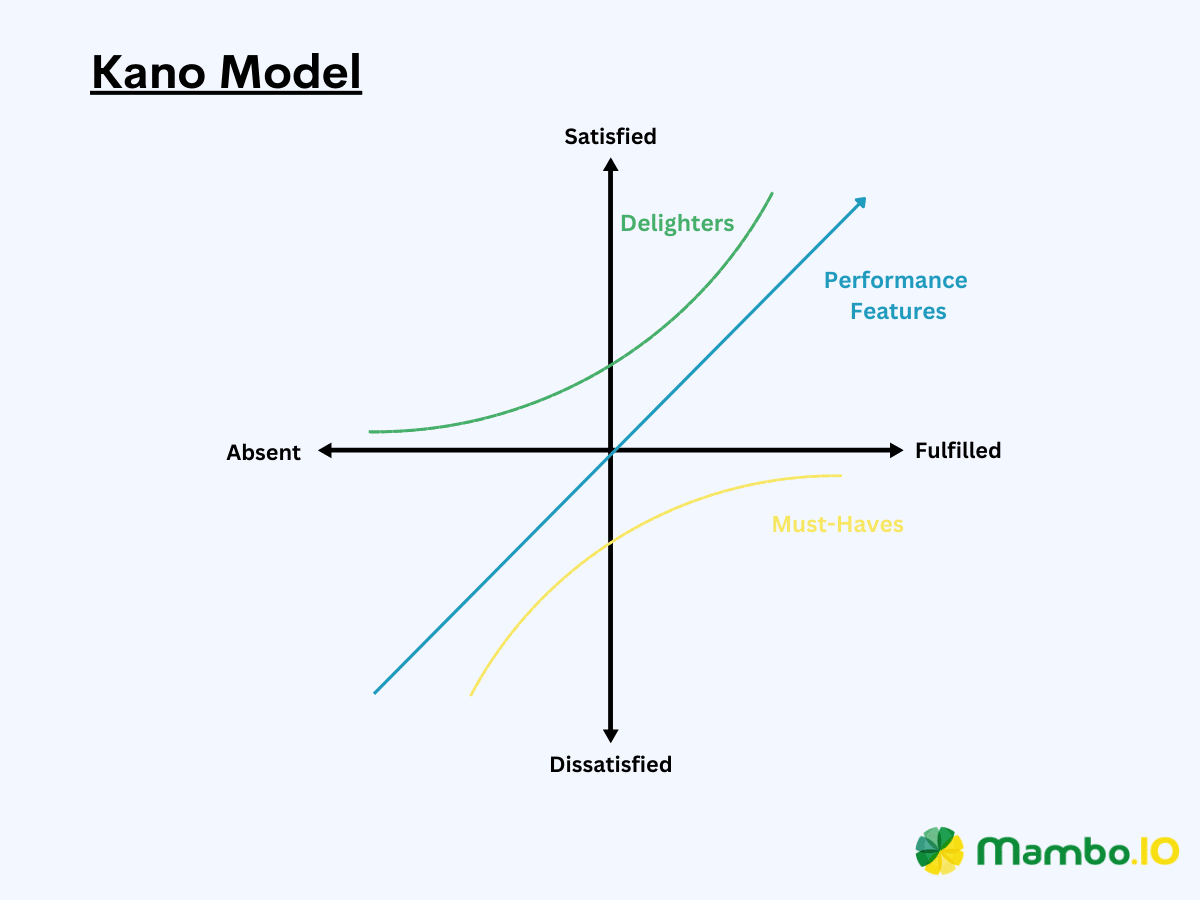
Pros of the Kano model
- Deeper user understanding. It allows organisations to understand user’s needs through customer feedback even better than the users understand their own.
- Customer-centricity. It allows businesses to put their users under the spotlight.
- Proper expectations. This framework can teach product teams to neither overestimate nor underestimate certain features.
Cons of the Kano model
- Time-consuming. The Kano questionnaire requires numerous surveys and customer feedback in proportion to the number of users to get fair representation.
- User confusion. Your users may need help understanding the questionnaire’s content or importance.
#4. Story Mapping
Story mapping is a straightforward yet effective prioritization technique for identifying and arranging must-work-on features based on user stories. This framework allows product teams to understand product features better while aligning them with the customer’s perspective.
The prioritization process involves two key axes. The horizontal axis represents the customer journey, chronologically arranged to reflect the user’s workflow as they interact with the product. The vertical axis, on the other hand, serves to label features based on their importance.
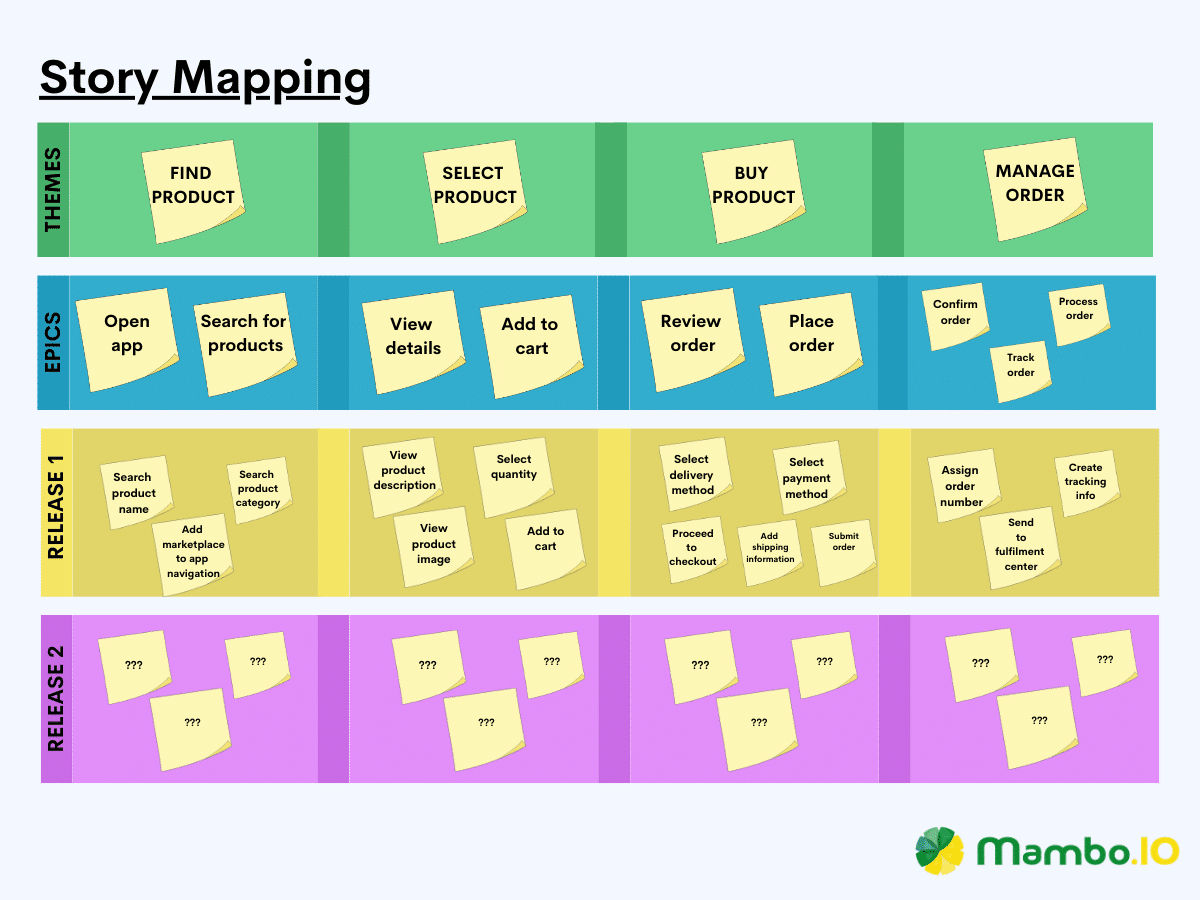
Once the user stories are thoughtfully laid out, you can seamlessly organise and divide them for subsequent releases and sprints.
Pros of story mapping
- Better perspective. Story mapping provides a holistic view of product features and releases.
- Quick and efficient. This framework is ideal for product managers who want to identify their MVPs fast.
- Focus on user value. This unique outside-in perspective produces a properly laid-out story map that leads to the best user experience.
Cons of story mapping
- Requires deep understanding of users. Properly representing users and their needs and preferences will require significant user research.
- Overemphasis on user perspective. It doesn’t involve external product prioritization factors.
#5. MoSCoW Method
The MoSCoW method is a dynamic prioritization framework that helps product teams identify the features to work on quickly. Let’s take a slightly deeper look at what the term actually means.
- Must-haves. These are the non-negotiable features necessary for the product’s success.
- Should-haves. These features are important but are less essential than must-haves.
- Could-haves. These features are “nice to have” but don’t necessarily provide additional benefits or potential enhancement to the product.
- Won’t have. These are the least critical features that stakeholders have explicitly agreed not to include in the product.
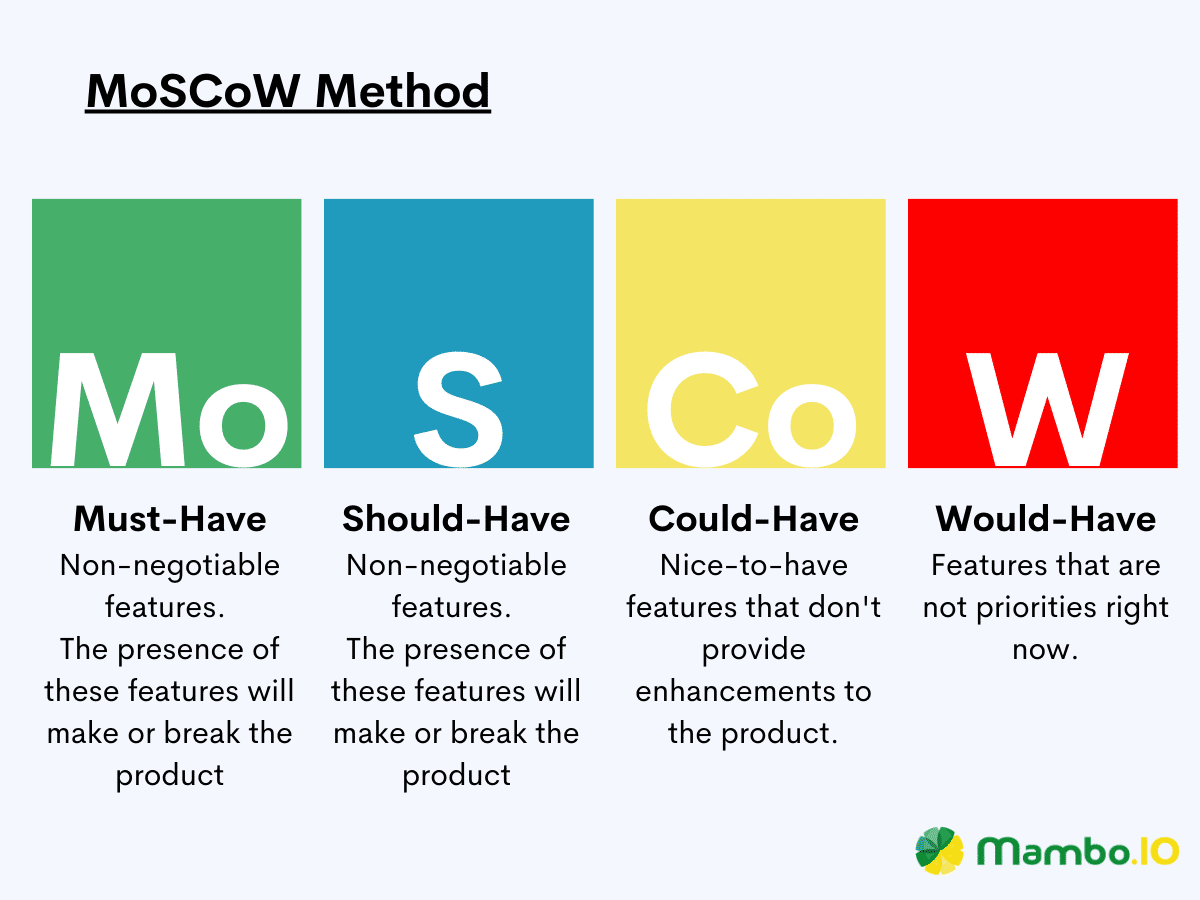
These four buckets allow product teams to focus on delivering the most critical features while clarifying what shouldn’t be included.
Pros of the MoSCoW method
- Clear categorisation of features. This prioritization framework organises each feature well, making it easier to communicate the results to the stakeholders.
- Quick, easy, and intuitive. The MoSCoW method is an efficient tool that helps make difficult decisions about which features to consider and postpone.
- Clarity. The categorisation provides product development teams with a clear direction on what needs attention and what needs to be ignored.
Cons of MoSCoW method
- Overestimated must-haves. The stakeholders may get tempted to overestimate the number of must-have features to include.
- Doesn’t account for importance. This prioritization framework doesn’t touch on the importance of the features included within each category.
#6. Opportunity Scoring
The Opportunity Scoring prioritization framework identifies the features based on their strategic fit and potential impact. It uses a graph that plots the rank opportunities based on the importance of the feature and the customer’s satisfaction.
Coming up with the data for this graph requires product managers to gather customer feedback two simple questions:
- How important is this particular feature?
- How satisfied are you with the existing features?

The results produced by the Opportunity Scoring framework will show what features matter to your users most. The low scores will reveal those that don’t satisfy the users, giving you insight into which features to prioritize for your next sprint.
Pros of opportunity scoring
- Alignment. This framework incorporates strategic fit and potential impact, ensuring the features are aligned with the organisation’s goals.
- Easy to use. It is an innovative yet easy tool for making data-driven decisions through objective scoring.
Cons of opportunity scoring
- Difference in opinion. Each user is different, so the scores vary based on their perspectives.
- Subjective feedback. Users may overestimate or underestimate the perceived business value of each feature.
#7. Product Tree
The Product Tree is an interactive prioritization framework that allows you to eliminate initiatives that aren’t worth the team’s efforts. This framework is an innovation game where product managers “prune the tree”, leaving only initiatives that matter to the product.
It involves a product tree that represents the product roadmap, with its parts acting as follows:
- Trunk. Core features
- Branches. System functionalities
- Roots. Infrastructure
- Leaves. New ideas.
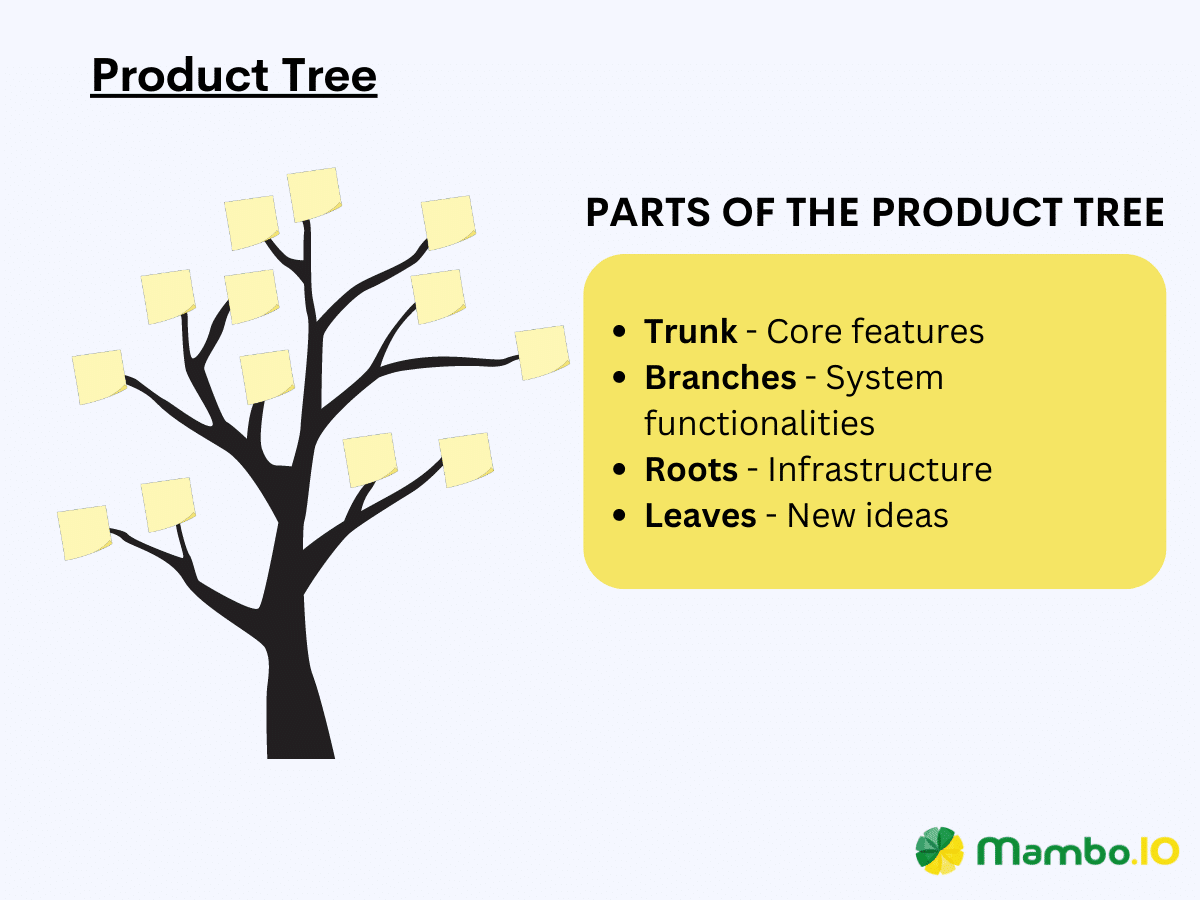
Here’s how the Product Tree framework works. The team will chip in their ideas using Post-Its or whiteboard markers and place them on the tree as leaves. Once everything’s set, you will “prune the tree” by deciding to relocate or remove the leaves. The closer the leaves are to the trunk, the more it impacts the product’s short-term growth.
Pros of the product tree
- Effective visual aid. It provides a convincing visual experience of balancing initiatives or product features.
- Highly collaborative. This framework allows you to utilise your team and customer insights without lengthy surveys.
Cons of the product tree
- Only a visual guide. It doesn’t provide product managers with quantitative data for prioritization.
- Vagueness. Since the ideas aren’t grouped into categories, they can be time-consuming to organise.
#8. Cost of Delay
This framework focuses on how the timing of feature implementation influences the user experience in the short and long term. In essence, it assesses how time affects the company’s desired outcomes. It’s a qualitative model employing dimensions like the delay and duration cost to prioritize features or initiatives. In practical terms, the higher the cost of delay for a feature, the more it should be prioritized by companies.
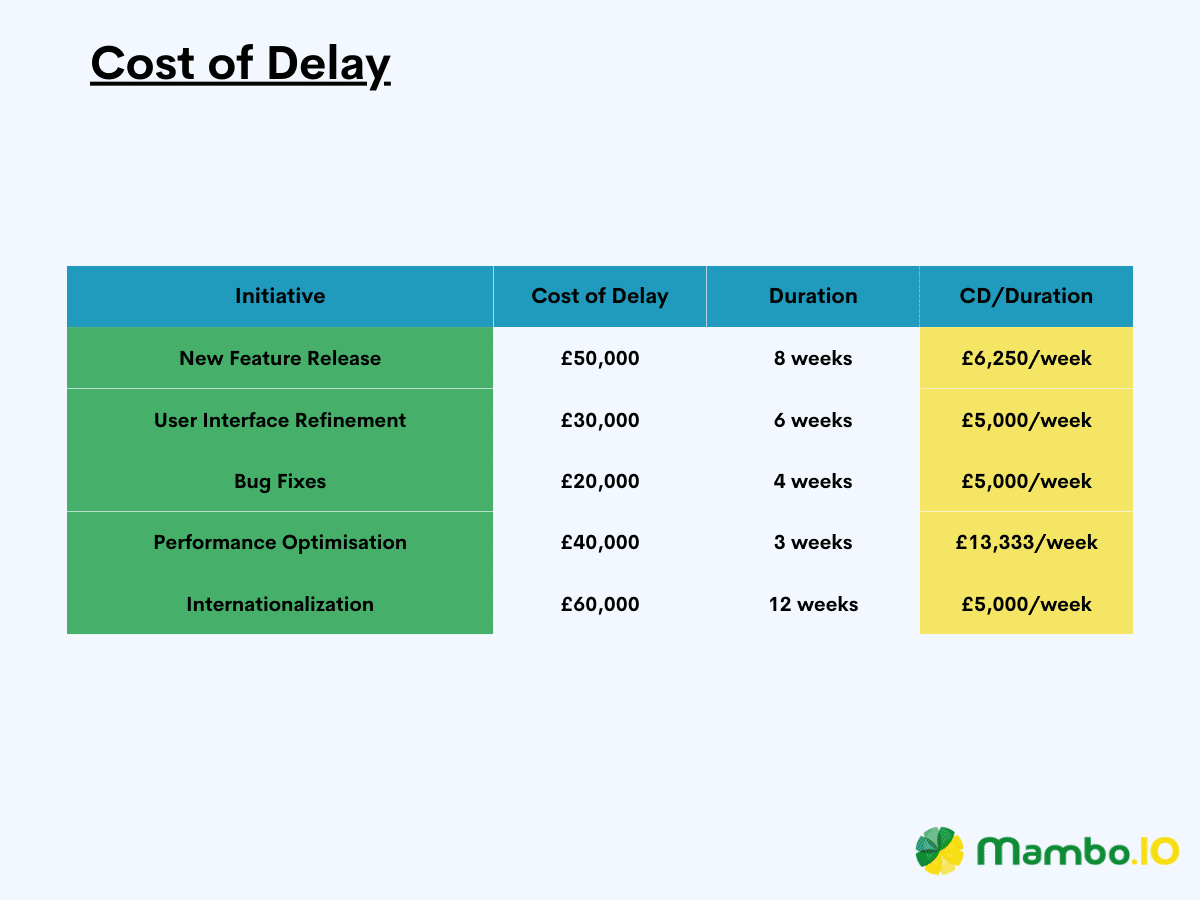
Pros of cost of delay
- Urgency. It emphasises the importance of timely delivery, eliciting a sense of urgency within the team.
- Revenue. It helps product managers identify features with potential revenue impact.
Cons of cost of delay
- Accuracy. Accurate estimation of potential revenue loss can be challenging
- Short-sighted. Results may not account for the long-term strategic value of features
#9. Buy-a-Feature
The Buy-a-Feature framework is another collaborative innovation game that tells how users perceive the business value of their features. The main idea is to allocate a limited budget to stakeholders and allow them to “buy” the most valuable features.
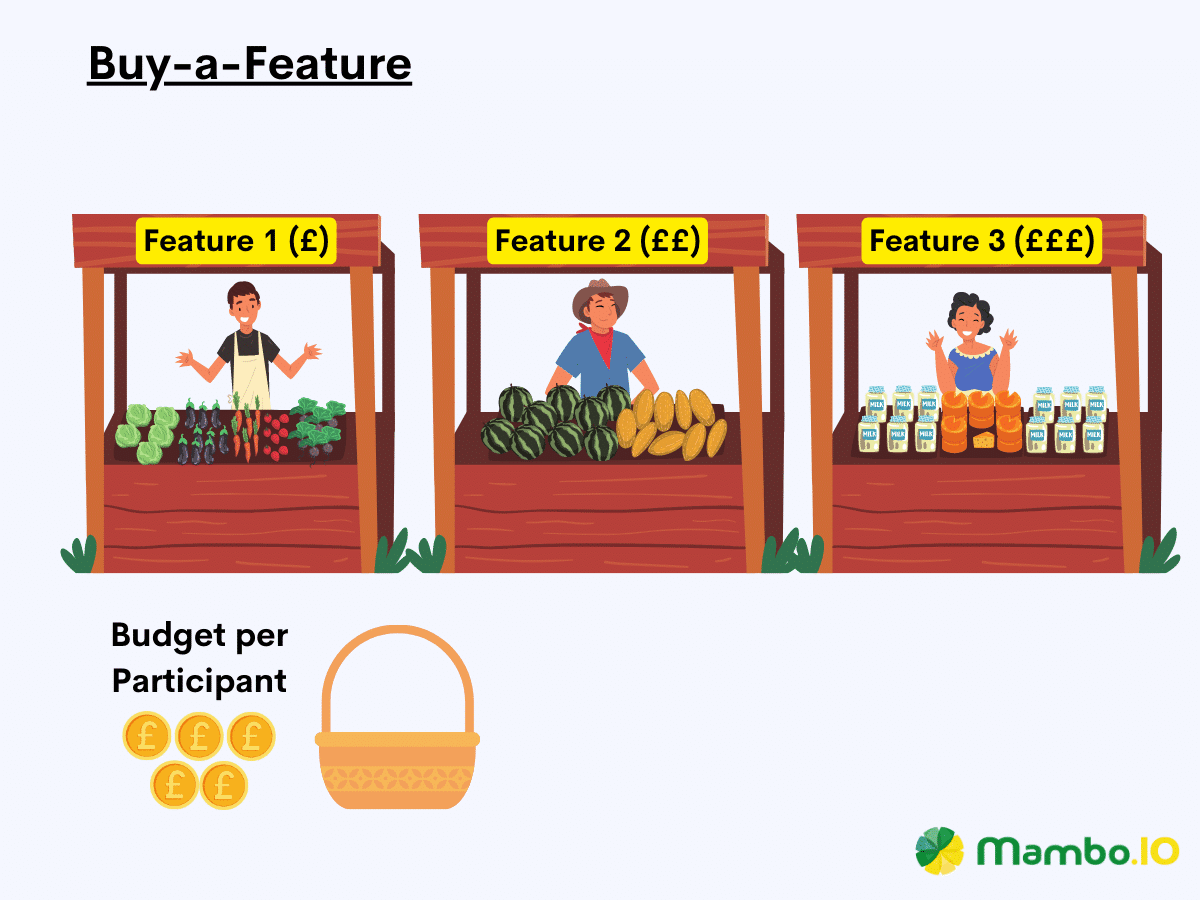
There are a plethora of ways to play this exercise. However, the simplest explanation would be to have each participant list down the features they think are essential. Then, each will spend some imaginary money to purchase the desired feature. The participant who successfully bought the most features wins.
Pros of buy-a-feature
- Stakeholder engagement. It promotes a sense of ownership and buy-in for the final decisions amongst the shareholders.
- Resource allocation. The budget constraints allow for critical thinking and proper resource allocation to the right features.
- Insight generation. It’s similar to a bidding process, which opens up fresh insights which can be used to enhance the team’s decision-making.
Cons of buy-a-feature
- Subjectivity. The subjective judgement from stakeholders may lead to biases and differences in prioritization.
- Budget constraints. The fixed budget given to the participants may not represent the real budget constraints the development team may face.
#10. Weighted Scoring
Sometimes, it’s much more insightful to let the weight of each feature or initiative speak for themselves. The Weighted Scoring prioritization framework shines the most in this scenario, as it helps product managers evaluate tasks using different criteria.
This scoring system assigns each feature a value, typically from 1 to 10. Then, the product manager will order and prioritize them based on their point value, from highest to lowest. Remember that multipliers may be applied, but this depends on the situation.
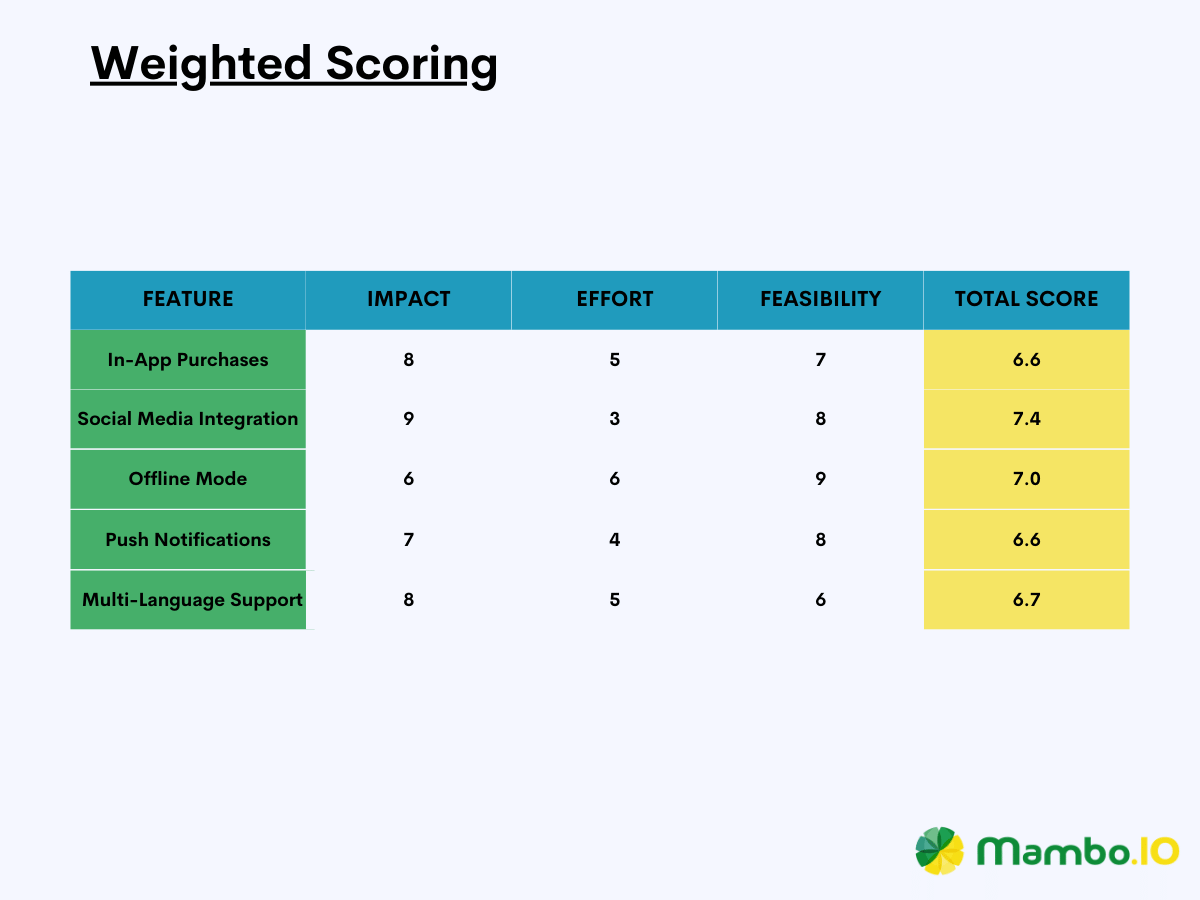
Pros of weighted scoring
- Comprehensive evaluation. This framework permits a comprehensive look into the features.
- Objectivity. It’s an objective and data-driven approach with minimum biases and subjectivity involved.
- Flexibility. It’s adaptable and can easily be tailored to different products by adjusting the criteria and weights.
Cons of weighted scoring
- Availability of data. Outdated or faulty data can cripple the accuracy of the results.
- Complexity. Using this framework to deal with many features and criteria can be challenging and time-consuming.
#11. ICE Scoring Model
The ICE Scoring Model is much like the RICE framework but uses different dimensions. It provides a simple and quick way to evaluate, prioritize, and rank features, ideas, and initiatives using the three dimensions.
The term ICE stands for:
- Impact. The estimated effect of the feature or initiative on the goal or metric the product development team is trying to achieve.
- Confidence. The level of certainty that said features or initiatives will deliver the expected impact.
- Ease. How easy or challenging would it be for the team to implement?
After obtaining these three figures, you can multiply them to get the ICE score of a particular feature or initiative. The higher the score, the better the candidate is to be prioritized.
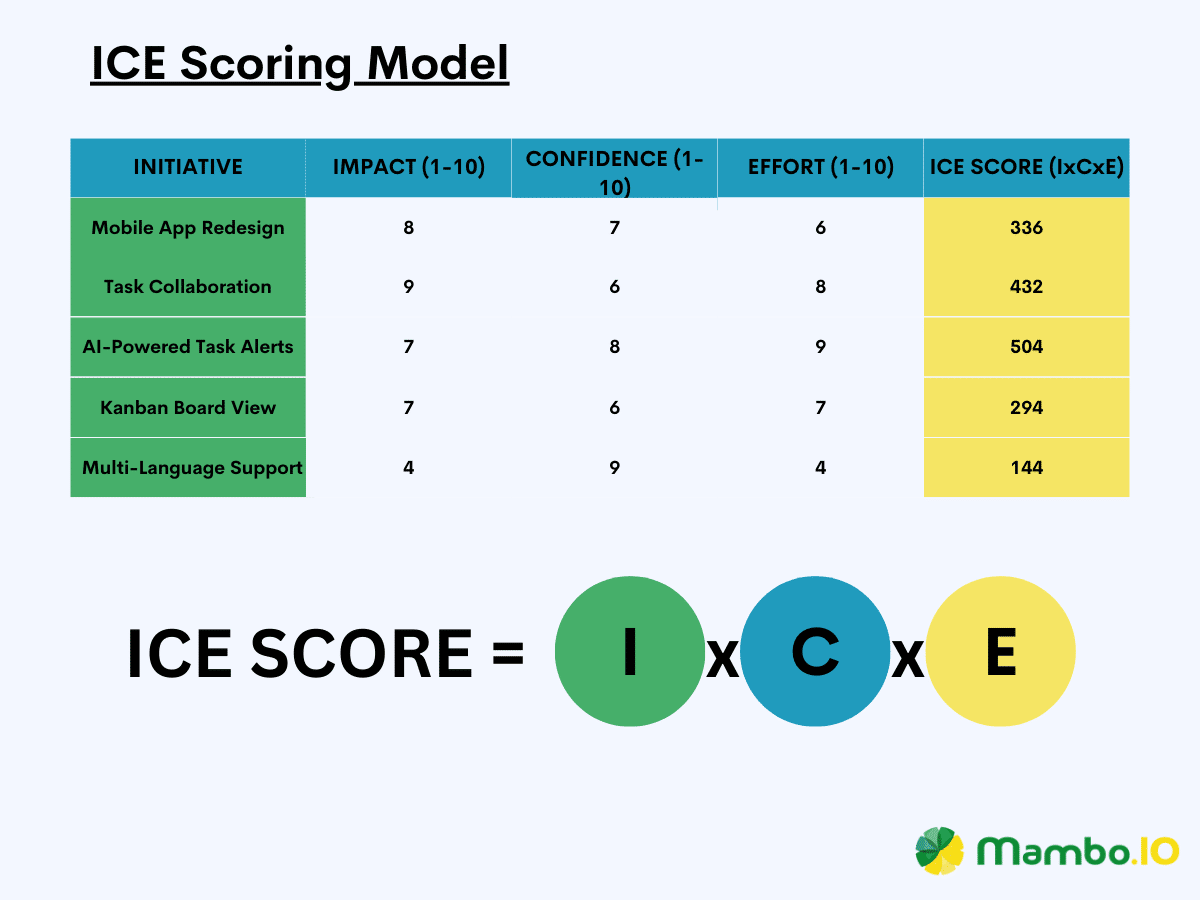
Pros of the ICE scoring model
- Simplicity. This model is straightforward to use.
- Holistic evaluation. It considers multiple dimensions to provide a more comprehensive evaluation of each feature.
- Time-efficient. This model is suitable for fast-paced teams that want to prioritize tasks efficiently.
Cons of the ICE scoring model
- Limited complexity. It may need to account for complex interdependencies or long-term strategic value.
- Lack of precision. The imprecise numerical weights for each dimension can limit more nuanced prioritization.
#12. Priority Poker
Priority Poker is a collaborative prioritization technique that can help product managers prioritize features and initiatives via “playing poker”. The idea is to use a poker deck to class features and let the product team compare and vote priorities. This happens in a structured and interactive manner where relative prioritization is exercised.
Pros of priority poker
- Collaborative decision-making. It encourages active involvement among team members.
- Relative prioritization. Frameworks that use relative prioritization avoid the need for assigning precise numerical values to each feature.
- Efficiency. This time-efficient prioritization framework makes it an ideal choice for agile development processes.
Cons of priority poker
- Group dynamics. Some team members with strong personalities may influence the outcome of the exercise.
- Limited precision. Since it uses relative prioritization, it may not offer precise numerical rankings of each item.
#13. KJ Method
The KJ Method (AKA affinity diagramming) is a brainstorming tool some product managers use to organise ideas into logical groups. It’s a simple framework that allows team members to focus on essential features or initiatives. Additionally, it’s a reliable tool for eliminating any ideas that might pose a distraction.
Pros of the KJ method
- Consensus-building. This prioritization process allows the participants to determine the groupings collectively and lets them choose areas of focus.
- Organised. This framework is ideal for organising multiple features into logical groups, making understanding and analysing them easier.
Cons of the KJ method
- Time-consuming. It may be challenging to execute this exercise on teams with many participants.
- Individual differences. Not all participants have different communication styles, therefore impacting the brainstorming process.
#14. Constraints Framework
Product development involves a lot of constraints that all product teams must learn how to manoeuvre around. For these kinds of situations, the Constraints framework helps a lot. It’s a prioritization framework that identifies and considers various limitations when making decisions. Some product managers consider this an excellent tool for identifying their MVP.
Pros of constraints framework
- Realistic prioritization. Using this prioritization framework ensures realistic and feasible results.
- Strategic alignment. Since you considered realistic constraints, you’re aligning the results to the organisation’s long-term goals.
- Risk mitigation. This framework is ideal for addressing potential challenges and limitations early in decision-making.
Cons of constraints framework
- Data availability. This prioritization framework relies on the availability of accurate data, so inaccurate information can lead to misleading outcomes.
- Dynamic nature. An organisation’s constraints may change over time.
#15. Weighted Shortest Job First Framework (WSJF)
The Weighted Shortest Job First is a strategy typically used in Agile development and lean product management. It’s ideal for optimising resource allocation and delivering high-value items efficiently. It works by assigning weights to features and using ranking them, making the highest-weighted feature the most important.
While various ways exist to assign these weights, successful product managers suggest using the formula below.
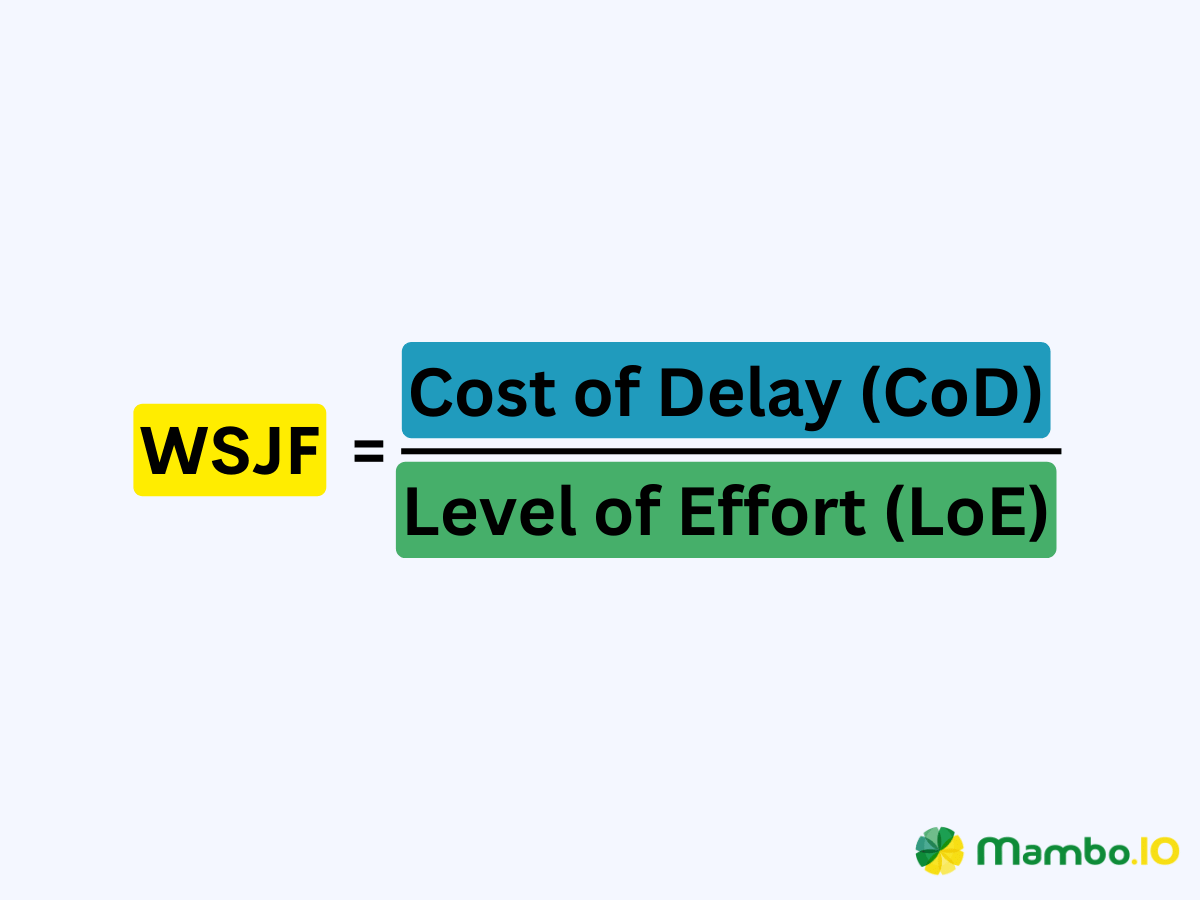
Prioritising features that drive the highest value (CoD) and can be delivered quickly (LoE) will give you the best investment return.
Pros of the weighted shortest job first
- Continuous alignment. The iterative nature of this framework allows for continuous alignment with the organisation’s evolving goals.
- Resource optimization. This framework ensures that resources are allocated efficiently.
- High-value items first. WSJF helps teams focus on high-value features and initiatives.
Cons of weighted shortest job first
- Effort estimation challenges. Accurately estimating the effort needed for each feature or initiative can be challenging.
- Neglects dependencies. This framework doesn’t account for dependencies between each feature or initiative.
- Constant reevaluation. An organisation’s priorities and resource availability constantly change. Therefore, the WSJF must continually be updated.
How to choose the right prioritization framework for your team
Here at Mambo.io, we cannot overstate the importance of choosing the proper framework for your product teams. The right framework can help eliminate all the delays and problems you might encounter along the product development process. With this in mind, we’ve created a table to help you choose the perfect prioritization framework for your team.
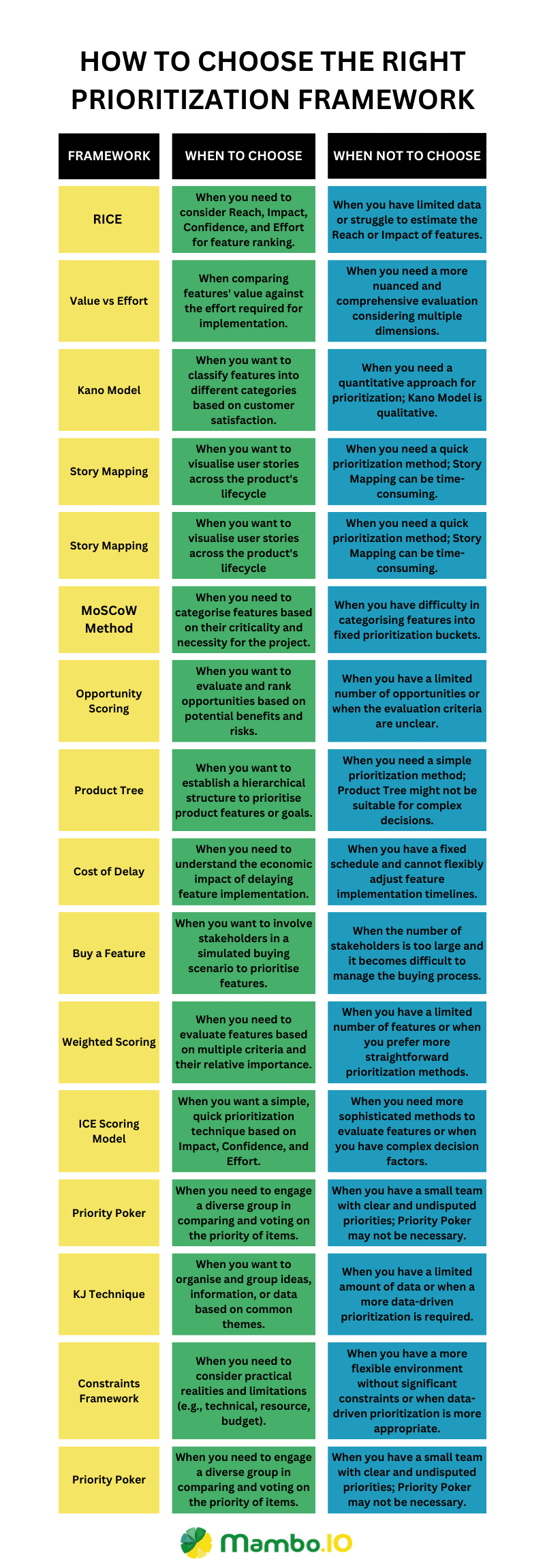
Latest Posts
Machine Learning In Finance: 12 Essential Applications
The impact of machine learning on finance is significant. Thanks to this technology, financial institutions are now equipped to make efficient decisions. Through the analysis of data sets, machine learning […]
How To Create Interactive Compliance Training For Bank Employees
Banking compliance training isn’t just another task. It’s the stage where everything else performs. Banks must navigate a myriad of regulations and laws. After all, this is a trust-driven, high-stakes […]
How Fintech Apps Are Using Gamification To Increase User Engagement
Discover how gamification in fintech is revolutionizing financial engagement, making banking fun & boosting user loyalty.




